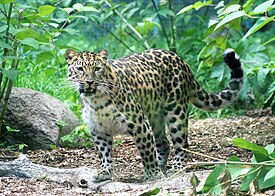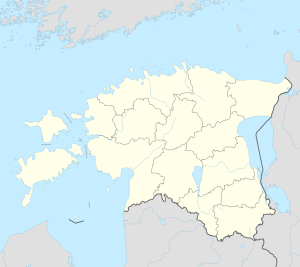Tallinn Zoo
| Tallinn Zoo | ||
|---|---|---|
| Full name | Tallinn Zoo Tallinna Loomaaed |
|
| place | Ehitajate tea 150 / Paldiski mnt. 145 13517 Tallinn |
|
| surface | 88.6 hectares | |
| opening | 1939 | |
| Animal species | 416 species (Jan. 1, 2015) | |
| Individuals | 4447 animals (Jan. 1, 2015) | |
| Visitor numbers | 350,195 (2014) | |
| organization | ||
| management | Mati Kaal | |
| Funding organizations | Tallinna Loomaaia Sõprade Selts (Friends of Tallinn Zoo) |
|
| Member of | WAZA , EAZA , EARAZA , VdZ | |
|
Amur leopard in Tallinn Zoo |
||
| http://tallinnzoo.ee/ | ||
|
|
||
Coordinates: 59 ° 25 ′ 14.6 ″ N , 24 ° 39 ′ 28.9 ″ E
The Tallinn Zoo ( Estonian Tallinna Loomaaed ) is the only zoo in Estonia .
The zoo was founded on August 25, 1939. Two years earlier, a group of Estonian marksmen not only won the so-called Argentina Cup at the World Championships in Helsinki , but also a lynx, which was used as an opportunity to found a zoo. The importance of the lynx for Tallinn Zoo can be seen from the fact that the lynx is now the zoo's heraldic animal. All lynx in Tallinn Zoo are descendants of the first Helsinki lynx.
In the early 1980s he moved from the center to a former military site on the outskirts of the city.
In 1989 the zoo became the first zoo in the Soviet Union to become a member of the World Association of Zoos and Aquariums (WAZA). Around ten years earlier, they became a sponsoring member of the American Zoo & Aquarium Association .
The director of the zoo is Mati Kaal . Currently around 4400 animals of over 400 species are kept on an 88.6 hectare site.
Tallinn Zoo is in the middle of a long-term modernization project, of which large parts (e.g. elephant facility, facilities for various mountain-dwelling goat species) have already been completed. In sharp contrast, there are still some enclosures from the Soviet construction period, which no longer meet modern animal husbandry requirements and which are also to be gradually replaced.
In 2014, over 350,000 people visited Tallinn Zoo.
Breeding program
According to the company's own information, the main breeding areas are lynx , mountain goat species , sheep , eagles , vultures and cranes . A herd of over 100 David deer also ensures numerous offspring, some of which are released back into the wild in China.
In the mid-1990s, the first European mink (one of the rarest mammals in Europe) was bred in captivity. Since then, the little nerubs have been throwing seven to ten offspring each year, some of which are released into the wild in Estonia.
In 2006 a special enclosure for Amur leopards was opened, the concept of which was created by employees of the Rotterdam Zoo , and in June 2008 three young animals were born.
Web links
- official website of the zoo (Estonian or English)
Individual evidence
- ↑ a b c d Datasheet on Tallinn Zoo ( Memento of the original from October 4, 2015 in the Internet Archive ) Info: The archive link was inserted automatically and has not yet been checked. Please check the original and archive link according to the instructions and then remove this notice. on the homepage of the Association of Zoological Gardens, accessed on September 30, 2015.

